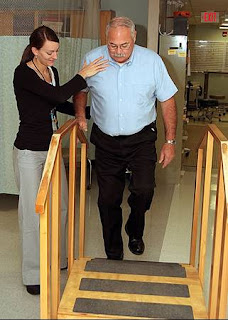Gunnar Mossberg
Tuesday, August 14, 2012
Up to 80 percent of people will at some point experience acute low
back pain, and in most cases it will resolve on its own within four to
six weeks, but with a high recurrence rate. However, recent large
studies have shown that early start of physical therapy treatment may
lead to less need for additional health-care treatment down the road.
A new study led by physical therapist Julie M. Fritz, published in the
medical journal Spine, used a national database of employer-sponsored
health plans, where 32,070 patients had newly consulted a primary care
physician for low back pain. Those who were referred to a physical
therapist within 14 days of consultation were compared to patients who
had their physical therapy referral delayed until 15 to 90 days after
initial consultation with a physician.
During an 18-month follow-up, the researchers found that early
physical therapy treatment was associated with reduced likelihood of
subsequent surgery, injections, physician visits, opioid use, advanced
imaging, along with a corresponding reduction in related medical costs
relative to delayed treatment by a physical therapist. The total
health-care cost was $2,736 lower in the early treatment group.
Another recently published study, taken from data from the Centers for
Medicare and Medicaid Services, looked at 439,195 patients who
received treatment for acute low back pain, and who received physical
therapy in the acute phase (less than 4 weeks) versus in the chronic
phase (more than 3 months). This study also showed less subsequent
medical services among patients who received physical therapy early
after an episode of acute low back pain, versus later on. Fritz
suggested that early physical therapy may promote a greater sense of
self-reliance in managing low back pain and confidence in a positive
outcome. It may also prevent patients’ dependency on additional health
care services and medications.
Although the literature has shown evidence of moderate benefit of
exercise therapy for chronic and sub acute low back pain, a systematic
review has shown strong evidence that exercise can reduce the future
occurrence of back problems in adults.
Gunnar Mossberg, PT, MOMT, DPT, has practiced physical therapy in San
Diego since 1982
Early proper treatment can be crucial to be preventive of chronic
illness behaviors.
--
Hyunsuk Oh, DC, CCEP, CKTP, ART®, GT®
Dr. Hyunsuk Oh graduated from Life University in Marietta, Georgia. Dr. Oh currently holds licenses to practice chiropractic in Maryland and Virginia. He is a member of the Maryland Chiropractic Association, American Chiropractic Association and International Chiropractic Association. Dr. Oh has undergone extensive training and has earned the designate of Certified Chiropractic Extremity Practitioner (CCEP) from the Council on Extremity Adjusting. He has also obtained certification as a Golf Rehabilitation Specialist through Blanchard Institution. Dr. oh has achieved Advanced Certification in the Graston Instrument Assisted Soft-Tissue Mobilization (GISTM) technique (or Graston Technique), a highly advanced and efficient technique developed for treating soft tissue pathology. He also has achieved Advanced Certification in the SASTM (Sound Assisted Soft-Tissue Mobilization). Dr. Oh is also a full body licensed provider of Active Release Techniques (ART). This technique is highly effective for treating a whole host of soft tissue and nerve entrapment issues. ART is a favorite technique of triathlon participants, volleyball players, marathon runners, and athletes of all sports. Dr. Oh is also a Certified Kinesio® Taping Practitioner (CKTP®). The Kinesio® Taping Method is one of the most sophisticated taping techniques in the world. It allows for facilitation, inhibition, and functional corrections of the musculoskeletal system.
Laurel Regional Chiropractic maintains an active presence on many popular search and social media websites. Select your favorite website below to stay connected or review us.











